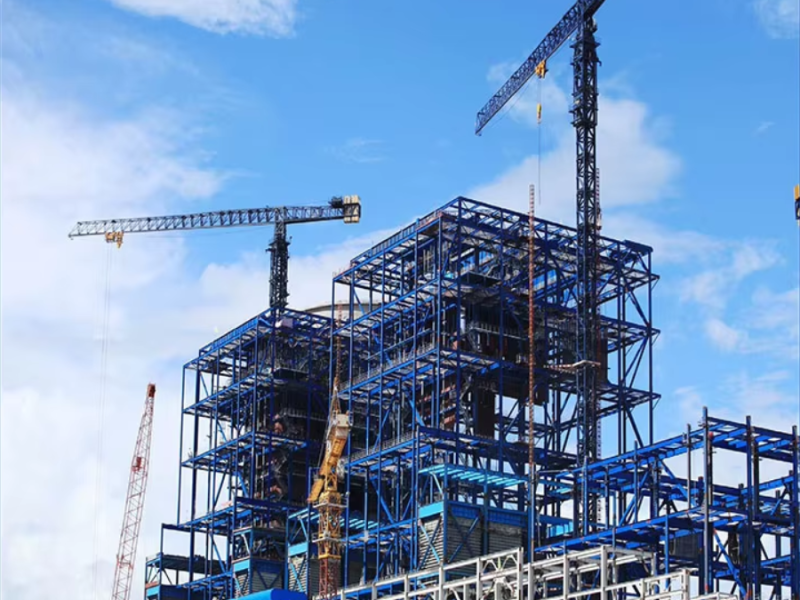
Steel Cattle Barns: Building Durable and Efficient Housing for Modern Dairy and Beef Farms
Cattle farming is evolving rapidly as producers strive for higher efficiency, better animal welfare, and lower operational costs. Traditional wooden or concrete barns often fall short—they are expensive to maintain, slow to build, and lack flexibility for modern equipment and herd management systems.
Steel cattle barns provide a smarter solution for both dairy and beef operations. With their prefabricated design, strength, and adaptability, these barns offer an ideal combination of durability, hygiene, and long-term cost savings. This article explores how steel cattle barns support the productivity, comfort, and sustainability goals of modern farms.
Why Choose Steel Cattle Barns?
Steel cattle barns are constructed using galvanized steel frames, insulated panels, and corrosion-resistant roofing systems. Unlike conventional barns, they are pre-engineered for precision, quick assembly, and long-term resilience.
They can be customized for dairy parlors, feeding areas, milking stations, or calving sections—all under one integrated structure. The modular nature of steel barns allows farmers to expand or reconfigure layouts as herd sizes grow or operations evolve.
Key Advantages of Steel Cattle Barns
- Exceptional Durability
Steel structures withstand heavy loads, harsh weather, and corrosive conditions from manure and moisture—ensuring a lifespan of decades with minimal maintenance. - Fast and Cost-Effective Construction
Prefabricated components reduce construction time by up to 60% compared to traditional barns, allowing farms to start operations faster. - Improved Animal Comfort
Open-span designs, natural ventilation, and thermal insulation help maintain a stable, comfortable environment for cattle year-round. - Easy Maintenance and Cleaning
Smooth surfaces prevent bacterial buildup and are simple to clean, improving biosecurity and reducing disease risks. - Energy Efficiency
Insulated panels reduce heat transfer, minimizing energy use for ventilation and cooling systems. - Customizable Layouts
Flexible designs accommodate various functions—feeding lanes, milking parlors, or resting zones—without structural limitations. - Long-Term Value
Steel barns require less repair, lower insurance costs, and offer better return on investment over time.
Design Considerations for B2B Clients
When planning a steel cattle barn, B2B clients should evaluate:
- Ventilation System: Natural or mechanical airflow to maintain air quality and reduce heat stress.
- Space Requirements: Stall dimensions and feeding zones must meet herd size and animal welfare standards.
- Drainage and Waste Handling: Sloped floors and efficient drainage systems ensure hygiene and reduce odor.
- Lighting and Insulation: Proper daylight access supports cattle productivity and comfort.
- Future Expansion: Modular structures allow seamless additions without interrupting existing operations.
Applications Across the Cattle Industry
Steel cattle barns are suitable for multiple farming operations:
- Dairy Farms: Housing for milking cows with integrated ventilation and feed systems.
- Beef Cattle Farms: Open-span feeding areas designed for easy access and efficient management.
- Breeding Operations: Controlled environments for calving and raising young stock.
- Mixed Livestock Farms: Adaptable barns supporting both cattle and other livestock facilities.
Case Studies
- Dairy Farm Expansion (Netherlands):
A 1,200-head dairy farm added a prefabricated steel barn with natural ventilation and insulated roofing. Construction was completed in six weeks, cutting costs by 35%. - Beef Operation (Argentina):
Modular steel barns replaced outdated concrete sheds. The farm reported improved airflow, easier cleaning, and a 15% increase in feed efficiency. - Integrated Livestock Facility (USA):
Built a combined cattle and pig housing complex using modular steel barns, simplifying maintenance and improving animal health standards.
Why B2B Clients Choose Steel Cattle Barns
Steel cattle barns provide a competitive edge for professional farming enterprises:
- Speed and Efficiency: Faster construction and minimal downtime.
- Structural Strength: Withstands environmental challenges and animal pressure.
- Operational Flexibility: Easily reconfigured for changing herd needs.
- Enhanced Animal Welfare: Proper ventilation, temperature control, and space allocation.
- Cost Savings: Reduced maintenance, longer lifespan, and lower insurance costs.
- Sustainability: Recyclable materials and energy-efficient systems support eco-friendly agriculture.
For B2B clients in the livestock sector, steel cattle barns offer scalable, durable, and cost-effective solutions for modern production demands.
Conclusion
Steel cattle barns redefine the future of dairy and beef farming by providing durable, flexible, and efficient housing solutions. With prefabricated components, customizable layouts, and superior ventilation systems, these barns deliver long-term performance and animal comfort.
For B2B clients, investing in a steel cattle barn means building a stronger, cleaner, and more profitable future for their livestock operations.
